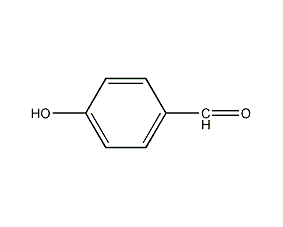
Structural formula
| Business number | 03G4 |
|---|---|
| Molecular formula | C7H6O2 |
| Molecular weight | 122.12 |
| label |
p-formaldehyde phenol, Formaldehyde-based phenol, 4-Hydroxybenzaldehyde, paraben acid, p-Hydroxybenzoin aldehyde, 4-Hydroxybenzaldehyde, 4-Formyllphenol, aromatic compounds, Multifunctional solvent |
Numbering system
CAS number:123-08-0
MDL number:MFCD00006939
EINECS number:204-599-1
RTECS number:CU6475000
BRN number:471352
PubChem number:24848630
Physical property data
1. Properties: Colorless crystalline powder with a faint, pleasant aromatic odor.
2. Melting point (ºC): 117~119
3. Relative density (g/mL, 130/4ºC): 1.129
4. Solubility : Easily soluble in ethanol, ether, acetone, ethyl acetate, slightly soluble in water (solubility in water at 30.5°C is 1.38g/100ml), soluble in benzene (solubility in benzene at 65°C is 3.68g/ml)
5. Relative density (20℃, 4℃): 1.143117
6. Relative density (25℃, 4℃): 1.136
7. Refractive index (n130D): 1.5705
Toxicological data
1. Acute toxicity: rat oral LD50: 3980mg/kg; mouse peritoneal cavity LD50: 500mg/kg
2. Mutagenicity: human lymphocyte double chromosome exchange test system: 1mmol /L
3. Irritating to eyes, respiratory system and skin.
Ecological data
None yet
Molecular structure data
1. Molar refractive index: 34.88
2. Molar volume (cm3/mol): 99.5
3. Isotonic specific volume (90.2K ): 367.3
4. Surface tension (dyne/cm): 52.0
5. Polarizability (10-24cm3): 13.83
Compute chemical data
1. Reference value for hydrophobic parameter calculation (XlogP): None
2. Number of hydrogen bond donors: 1
3. Number of hydrogen bond acceptors: 2
4. Number of rotatable chemical bonds: 1
5. Number of tautomers: 4
6. Topological molecule polar surface area 37.3
7. Number of heavy atoms: 9
8. Surface charge: 0
9. Complexity: 93.1
10. Number of isotope atoms: 0
11. Determined number of atomic stereocenters: 0
12. Uncertain number of atomic stereocenters: 0
� Carry out salting out. Filter the solid and liquid materials with a centrifuge, and put the obtained solid into a vacuum oven and dry it at about 60°C for 3-5 hours to obtain p-hydroxybenzaldehyde with a content of more than 98%.
4. Obtain needle crystals from water.
5. Preparation method: 
In reaction Add 496 mg (4 mmol) of p-hydroxybenzyl alcohol (2) and 24 mL of dioxane into the bottle, and then add 908 mg of 2,3-dichloro-4,5-dicyano-1,4-benzoquinone (DDQ) ( 4mmol), the reaction occurs immediately, producing dark green color (exothermic reaction), and DDQH2 precipitate is formed in about 1 min. Thin layer analysis showed that the reaction ended after 15 minutes. The solvent was evaporated under reduced pressure from the yellow reaction mixture, dichloromethane was added to the residue, and the insoluble matter (DDQH2, almost quantitative) was filtered off. The filtrate was concentrated to obtain compound (1) with a yield of 74%. Can be recrystallized from water. [1]
Purpose
This product is an intermediate for medicines, spices, and liquid crystals, and is also used as a solvent. P-hydroxybenzaldehyde is used to produce the antibacterial synergist TMP (trimethoprim), ampicillin, amoxicillin, artificial gastrodia, rhododendron, bezafibrate, and esmolol; used in the production of spices Anisaldehyde, vanillin, ethyl vanillin, raspberry ketone.

 微信扫一扫打赏
微信扫一扫打赏

